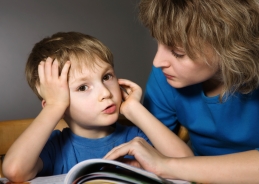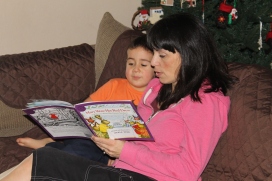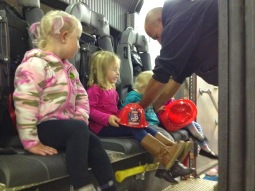On April 14, 1828, Noah Webster copyrighted his first dictionary. Think what a wonderful vocabulary Webster must have had in order to create this work! With that in mind, this is a great time to think about the importance of building vocabulary in young children. The more words children know, the easier it is for them to understand their world. So what are some good ways to help children learn new words?
1. Conversations: The best way for children to learn new words is by having frequent conversations. Conversations should involve both speaking and listening. Even before children speak words, they respond to speech with facial expressions and sounds. When we take the time to watch and listen, we can respond in ways that show we understand. Studies have shown that vocabularies improve when children are frequently involved in two-way conversations.
listening. Even before children speak words, they respond to speech with facial expressions and sounds. When we take the time to watch and listen, we can respond in ways that show we understand. Studies have shown that vocabularies improve when children are frequently involved in two-way conversations.
2. Responding to Children’s Interests: When toddlers first begin talking, they are full of curiosity about words. I remember when my daughter was learning to talk, she would point to everything in the room and ask, “Uh da?” (Translation: “What’s that?”) It could get tiring naming everything in the room, but that’s how she learned. Later, when I was teaching Head Start, I remember sitting with a group of children talking about the names of body parts. One youngster pointed to the indentation below his nose and asked me its name. I was floored! I had to tell him I didn’t know, but would find out. I had a doctor’s appointment coming up, so I asked the doctor. He didn’t know either. I finally found it in an anatomy book. It’s called a philtrum. The children in my class were so excited to learn that word! They used it at every opportunity. When children want to know a new word, it’s worth the time to help them.

3. Reading to Children: When we read books to children, they often hear words that may not come up in everyday conversation. The pictures in the books and the context of the story helps the children build a deeper understanding of the new words. Children often enjoy hearing the same story over and over again. While this can get old for adults, reading the same story often is a great way to help children gain a strong grasp of the vocabulary in the story.
4. Exploring the World: When we take the time to visit interesting places with children, vocabulary growth tends to follow naturally. Even if you are not able to travel to distant places, there are many interesting places to visit close to where you live. Do you have a grocery store? It probably has fruits and vegetables from many different places. Slow down and look at them with your children. Read the labels. You may even notice some that are new to you! If you don’t know where the foods are grown, try to find out. Think how excited the children will be to know the answer. Visit the post office, fire station, courthouse, or other places in the community. Is there a local children’s museum, planetarium, or nature center? Each place you explore with children offers new opportunities for vocabulary development.
the foods are grown, try to find out. Think how excited the children will be to know the answer. Visit the post office, fire station, courthouse, or other places in the community. Is there a local children’s museum, planetarium, or nature center? Each place you explore with children offers new opportunities for vocabulary development.
Children learn best when they are having fun! This is true for any type of learning and especially so for building vocabulary. You don’t need to drill children to build strong vocabularies. When you talk with children, respond to their interests, read good books to them, and explore the world together, you can be confident that the children will have outstanding vocabularies.
Back to blog listing